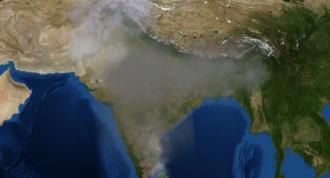
Our climate system is complex and intricate, and depends on a wide range of components that make it up -- air, temperature, pressure, moisture, etc. Any small change in the any of these will have a domino effect, leading to massive implications. One such component that is gaining importance is ‘carbonaceous aerosol’ which are fine particulates in the atmosphere. While scientists have found that aerosols contribute to the changing climate, a new study by researchers at the Indian Institute of Tropical Meteorology (IITM), Pune, has explored how these carbonaceous aerosols affect the different layers of our atmosphere. The black carbon aerosols and organic carbon aerosols togetherly known as carbonaceous aerosols.
Aerosols are diverse and widespread. Vehicular emissions, exhaust from coal-based power plants and industries, forest fires, residential biofuel and fossil-fuel combustion--all lead to aerosol emissions. Among the different types of aerosols, carbonaceous aerosols are important as they can bring about climate change, and alter the energy balance in the atmosphere as they absorb and scatter solar radiations, and affect precipitation patterns around the globe.
“Black carbon aerosols produce local warming”, says Dr. Suvarna Fadnavis from IITM, Pune, who is also the author of the study published in the journal Atmospheric Chemistry and Physics. The study focuses on the impact of carbonaceous aerosols on the thermal structure of the upper troposphere and lower stratosphere (UTLS)--A atmospheric region pertaining to higher altitudes (12-18 km), in South Asia and Southeast Asia. It also takes into effect the underneath monsoon circulation, for which analysis has been done during the monsoon season, from 20 years of global model simulations.
The researchers performed the global atmospheric Chemistry model simulations on High Performance Computer (HPC) system (at IITM) to study the impact of emissions of carbonaceous aerosols. The model accounts the emission of sulphate, black carbon, particulate organic matter, sea salt and mineral dust aerosols. Human induced activities and biological activities were also taken into account in these simulations.
The researchers found that emissions of black carbon aerosols are lifted up from the Earth’s surface to the upper troposphere (near 12-18 km) by the monsoon circulation. This causes instabilities in the mid to upper troposphere as the aerosols gradually spread over the Tibetan plateau and Indo-Gangetic plains, producing significant warming near 7-12 km, (400-200 hPa; 1 hectopascal = 100 Pascal). They also found that the emission of organic carbon aerosol was higher than black carbon aerosols over Asia, and the UTLS was heating up because of the higher absorption capacity of black carbon aerosols over organic carbon aerosols.
The study reveals that the aerosols have manifold implications, ranging from bringing about a change in the rainfall patterns and causing abnormal heating of the atmosphere through radiation. Interestingly, this heating, in turn, accelerate the upward movement of the aerosols into the next layer of the atmosphere, the stratosphere (~20km), which also heats up as a result. Rainfall pattern gets affected due to the impact on the cirrus clouds -- high level clouds in the atmosphere, and due to the formation of cloud ice near the tropopause (the interface between the troposphere and stratosphere). The impacts are more pronounced over the Tibetan plateau and the Indo-Gangetic plains, where their concentration and emission rates are relatively much higher.
“To study the climate change due to carbonaceous aerosols one would need minimum of 60 years simulations, whereas our study is only for 20 years. However, many recent studies have said that carbonaceous aerosols can substantially contribute to the climate forcing and their impacts on local meteorology and monsoon circulation are large”, says Dr. Fadnavis, talking about the importance of this study. In a planet that is fighting its battles of climate change at different levels, the implication of increasing carbonaceous aerosols is yet another challenge to knock down.






